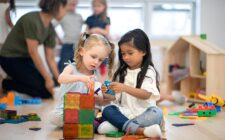Education is the cornerstone of society, shaping the minds and futures of countless individuals. However, the prevailing focus on grades and academic performance often overlooks the holistic development of students.
To truly nurture well-rounded individuals, we must embrace a growth mindset and adopt a holistic approach to education. This blog explores the concept of holistic education, the benefits it offers, and strategies for implementing it in the classroom.
What Is Holistic Education?
Holistic education goes beyond academics, emphasising the development of the whole child—mind, body, and spirit. It prioritises the nurturing of creativity, critical thinking, emotional intelligence, and social skills. Instead of relying on rote memorization and standardised testing, holistic education encourages lifelong learning and personal growth.
Holistic Learning: Nurturing Curiosity and Passion
Holistic learning empowers students to become active participants in their education. By fostering curiosity and passion, we can ignite a love for learning that extends beyond the confines of the classroom.
Holistic learning involves providing opportunities for self-directed learning, integrating real-world applications, and promoting interdisciplinary connections. By engaging students in hands-on experiences and projects, we enable them to develop 21st-century skills, such as problem-solving, collaboration, and adaptability.
What Is the Role of a Growth Mindset in Holistic Student Development?
A growth mindset is crucial in fostering holistic student development, allowing students to unlock their full potential and thrive academically, personally, and socially. Unlike a fixed mindset, which believes intelligence and abilities are fixed traits, a growth mindset is the belief that one’s abilities can be developed through dedication, effort, and perseverance.
Cultivating a growth mindset encourages students to embrace challenges, view failures as learning opportunities, and persist in the face of setbacks. By fostering resilience and a positive attitude towards challenges, students develop the confidence to explore new territories, take risks, and push beyond their comfort zones. This mindset shift empowers students to approach their education with enthusiasm and a hunger for continuous improvement.
A growth mindset also promotes a love for learning. Instead of focusing solely on grades and outcomes, students with a growth mindset value the learning process itself. They understand that intelligence and abilities can be developed through effort and practice, which encourages them to engage in deeper and more detailed learning experiences. They become more self-directed learners, actively seeking out new knowledge and skills that align with their interests and passions.
Moreover, a growth mindset fosters a sense of self-efficacy and self-belief. Students recognize that their abilities are not fixed, and their potential for growth is limitless. This mindset empowers them to set ambitious goals, work diligently towards them, and persist in the face of obstacles. As a result, they develop a strong sense of agency and ownership over their own learning journey.
What Are the Benefits of a Holistic Approach to Education?
Embracing a holistic approach to education yields numerous benefits that extend far beyond academic achievement. By prioritising the development of the whole child, holistic education addresses the diverse needs and potential of each student, fostering their overall well-being and personal growth.
One of the key advantages of a holistic approach is the enhancement of student well-being and mental health. By acknowledging and catering to their emotional and social needs, students feel seen, heard, and supported. This creates a positive and inclusive learning environment where they can thrive and build healthy relationships.
Holistic education also promotes a lifelong love for learning. By nurturing curiosity, passion, and self-directed learning, students develop an intrinsic motivation to explore and acquire knowledge beyond the confines of traditional subjects. They become active seekers of knowledge, constantly engaging in intellectual pursuits that align with their interests and aspirations.
Moreover, a holistic approach equips students with essential skills for success in the modern world. Students can dеvelop critical-thіnkіng, problеm-solvіng, and collaboration skills by using projеct-basеd learnіng, real-world applіcatіons, and intеrdіsciplinary connections. They can also receive practical training to put their knowledge and skills to use in actual circumstances.
How to Implement Holistic Education Strategies in the Classroom?
Bringing holistic education into the classroom requires intentional strategies. Creating a learner-centred environment that values diversity and individual strengths is crucial. This involves incorporating project-based learning, experiential learning, and collaborative activities that promote critical thinking and creativity.
Prioritising social-emotional learning helps students develop self-awareness, emotional regulation, and healthy relationships. Additionally, offering opportunities for self-reflection and goal setting enables students to take ownership of their learning and personal growth.
Conclusion
A holistic approach to education is paramount for nurturing well-rounded individuals. By embracing a growth mindset, prioritising holistic learning, and implementing strategies that support student development, we can reshape education to foster lifelong learners who are equipped to face the complexities of the modern world. Let us come together as educators, parents, and policymakers to empower students with the tools and mindset they need to thrive in an ever-changing society.




